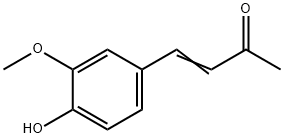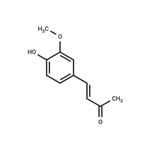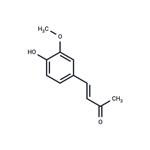Description
Dehydrozingerone (1080-12-2) is a structural half analog of curcumin (Cat.# 10-1243) and is isolated from ginger rhizomes. Dehydrozingerone displays antioxidant, antibacterial and antifungal properties.1 It has also been shown to possess various antitumor effects2,3 and inhibit growth factor/peroxide-stimulated vascular smooth muscle function4.
Chemical Properties
Vanillylidene acetone has a very sweet, warm and tenacious odor.
Physical properties
Yellowish, needlelike crystals. Slightly soluble in water, soluble in alcohol
and oils.
Uses
Vanillylidenacetone is one of ferulic acid derivatives. Studies have shown that vanillyl acetone has a certain inhibitory effect on Amaranthus, barnyardgrass, matang, dogwood and rape, among which the best inhibitory effect is on rape and Amaranthus.
Definition
ChEBI: Dehydrozingerone is a hydroxycinnamic acid.
Taste threshold values
Taste characteristics at 200 ppm: balsamic vanilla, with sweet aromatic spicy nuances.
References
1) Kubra et al. (2014), Structure-function activity of dehydrozingerone and its derivatives as antioxidant and antimicrobial compounds; J. Food Sci. Technol., 51 245
2) Motohashi et al. (1998), Inhibitory effects of dehydrozingerone and related compounds on 12-O-tetradecanoylphorbol-13-acetate induced Epstein-Barr virus early antigen activation; Cancer Lett., 134 37
3) Yogosawa et al. (2012), Dehydrozingerone, a structural analog of curcumin, induces cell-cycle arrest at the G2/M phase and accumulates intracellular ROS in HT-29 human colon cancer cells; J. Nat. Prod., 75 2088
4) Liu et al. (2008), Inhibitory effect of dehydrozingerone on vascular smooth muscle cell function; J. Cardiovasc. Pharmacol., 52 422




